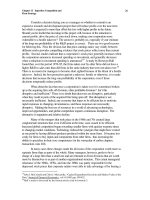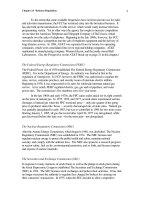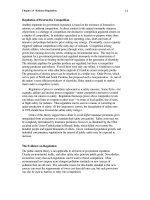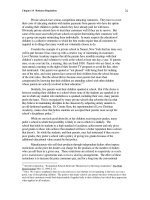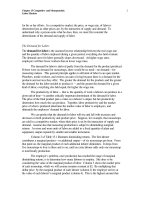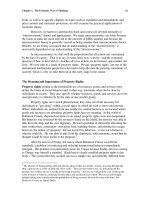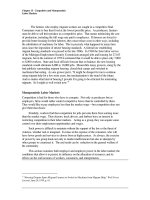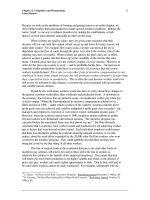Microeconomics for MBAs 47
Bạn đang xem bản rút gọn của tài liệu. Xem và tải ngay bản đầy đủ của tài liệu tại đây (245.46 KB, 10 trang )
Chapter 14 Business Regulation
4
To the extent that some available frequencies have not been put into use for radio
and television transmission, the FCC has restricted entry into the broadcast business. It
has also held up the introduction of cable service, which would vastly increase television
programming variety. Yet in other ways the agency has sought to increase competition.
At one time the American Telephone and Telegraph Company (AT&T) had a virtual
monopoly over the sales of telephones. Beginning in the late 1960s, however, the FCC
moved to introduce competition into the sale of telephone equipment and the delivery of
long-distance service. In 1984, AT&T was separated from its twenty-two operating
companies, which were consolidated into seven regional holding companies. AT&T
maintained its manufacturing company, Western Electric, and the jointly owned Bell
Laboratories. (See the Perspective on the AT&T break-up on page 21 in this chapter.)
The Federal Energy Regulatory Commission (FERC)
The Federal Power Act of 1930 established The Federal Energy Regulatory Commission
(FERC). It is in the Department of Energy. Its authority was limited at first to the
regulation of waterpower. In 1935, however, the FERC was authorized to regulate the
rates, service, corporate practices, and security issues of interstate electric utilities.
Beginning in 1938, it was empowered to fix rates for wholesale interstate natural gas
service. At its zenith, FERC regulated electric, gas, gas and oil pipelines, and water
power sites. The commission’s five members serve five-year terms.
In the late 1960s and early 1970s, the FPC came under attack for its tight controls
on the price of natural gas. In 1975, 1976, and 1977, several states experienced serious
shortages of natural gas when the FPC-restricted price -- only one-quarter of the going
price in producer states like Texas -- severely discouraged out-of-state sales. Natural gas
was partially deregulated in early 1983, but was re-controlled in 1984 for two more years.
Starting January 1, 1985, all gas discovered after April 20, 1977 was deregulated, while
gas discovered before this date was—for the most part—not deregulated.
The Nuclear Regulatory Commission (NRC)
After the Atomic Energy Commission, which began in 1946, was abolished, The Nuclear
Regulatory Commission (NRC) was established in 1974. The NRC licenses and
regulates nuclear energy to protect the public health and safety, maintain national
security, and comply with the antitrust laws. The NRC also sponsors a research program
in reactor safety, fuel cycles, environmental protection, and so forth, and licenses imports
and exports of nuclear materials.
The Securities and Exchange Commission (SEC)
In response to many instances of stock fraud, as well as the plunge in stock prices during
the Great Depression, Congress established The Securities and Exchange Commission
(SEC) in 1934. The SEC licenses stock exchanges and polices their activities. It has (but
no longer exercises) the authority to regulate fees charged by brokers for carrying out
their customers’ transactions. In 1975, when the SEC decided to allow competitive
Chapter 14 Business Regulation
5
determination of stockbrokers’ fees, those fees fell almost immediately by about 30
percent. The SEC also supervises the issuance of new securities by corporations and
disclosure of information relating to those issuances. The commission has five members,
who are appointed by the president for terms of five years. It has jurisdiction over
securities and financial markets, and electric and gas utility registered holding companies.
The Food and Drug Administration (FDA)
Food and drugs have been regulated to some degree since the turn of the century. Not
until 1931, however, was the Food and Drug Administration (FDA) established, as part of
the Department of Health, Education, and Welfare (now called the Department of Health
and Human Services). The FDA is responsible for ensuring the purity, safety,
effectiveness, and accurate labeling of certain foods and drugs. No prescription or over-
the-counter drug can be sold on the market before it has been judged safe and effective by
the FDA. The agency is also responsible for enforcing a wide variety of consumer
protection laws pertaining to the labeling, packaging, and advertising of foods and drugs.
The Occupational Safety and Health Administration (OSHA)
Probably no government regulatory agency is currently more controversial than the
Occupational Safety and Health Administration (OSHA). Organized in 1969, in response
to numerous reports that worker safety and health was not adequately protected, OSHA
has formulated thousands of health and safety standards. To meet its requirements
businesses have had to spend tens of billions of dollars. Those who believe government
has an important role in protecting workers have praised OSHA, suggesting that if
anything, the agency should conduct more inspections and impose higher fines to induce
businesses to meet established standards. Businesses, on the other hand, have
condemned OSHA’s expensive standards as ineffective and wasteful.
The Public Interest Theory of Regulation
Regulation has often been justified on the grounds that it is in the public interest, meaning
that it helps to achieve commonly acknowledged national goals. Some of the goals that
may be pursued through regulation include:
• a more democratic allocation of the nation’s resources (and a reduction in
the importance of profit in such decisions);
• an increase in market efficiency;
• enhancement of the nation’s ability to pursue certain essentially political
objectives—improvement of the national defense, redistribution of costs of
economic decisions, conservation of resources, and provision of certain
public goods, such as public safety.
Economists’ theories of regulation tend to be based on the goal of increasing market
efficiency. One of the sources of market inefficiency economists cite most frequently is
externalities, or third-party effects of market transactions.
Chapter 14 Business Regulation
6
Regulation to Capture Externalities
The market failure problems that externalities can cause were discussed much earlier.
You will recall that an externality or spillover is a cost or benefit imposed on or enjoyed
by other members of society by the activities of a producer or consumer that are not
borne or enjoyed exclusively by the direct cause. An information disparity or asymmetry
between producers and consumers is a form of market failure. Regulation is often
imposed to ensure public safety, an economic good that is sometimes, but not always, an
externality. Product features that ensure the safety of the purchaser—for instance, shock-
absorbing steering columns—can be handled with reasonable efficiency by the market.
Safety devices that benefit other persons, however, may not be provided by a market
system.
For example, shock-absorbing bumpers benefit not only the person who buys a car
but also those who may be involved in a collision with the buyer. If John collides with a
car protected by shock-absorbing bumpers he may sustain less damage than he would
have otherwise, without having paid for the protection received. He free rides on Mary’s
and the other driver’s purchase. Because of the externality, the quantity of shock-
absorbing bumpers purchased in an unregulated market will fall short of the economic
optimum. Hence the need for regulation of safety equipment like shock-absorbing
bumpers—and headlights, brakes, and/or windshield wipers.
Regulation sometimes benefits all producers, particularly when it enhances their
reputation for safety. If people believe that a given product is safe, unscrupulous
competitors may take advantage of the public’s faith by reducing the safety of their
products and cutting their production costs. Bad experiences with a product can make
consumers skeptical of all firms, thereby reducing the price they are willing to pay for
goods that may not prove to be safe. Thus by restoring consumer confidence, consumer
protection laws can actually benefit the food and drug industries and toy manufacturers.
To the extent that the SEC contributes to the securities industry’s reputation for honesty,
regulators can be seen as producers of public goods. However, externalities do not
necessarily require government intervention. In certain cases a rearrangement of property
rights may be more efficient.
Regulation to Curb Monopoly
Monopoly is frequently cited as a source of market inefficiency. The first regulatory
agencies were organized to deal with abuses of monopoly power. Monopoly can also be a
source of inequity if there is undue price discrimination, although there are circumstances
where price discrimination is socially optimal. If ownership of an industry is
concentrated in a few large corporations, they can form a cartel and behave as if they
were a monopoly, dividing the market, restricting output, raising prices, and distorting the
price structure. To do this profitably, however, requires that demand initially be inelastic
and entry be restricted somehow. During the 1970s and 1980s, the fear of such
monopoly power motivated proposals to regulate the oil and automobile industries,
among others.
Chapter 14 Business Regulation
7
Figure 14.1 shows a cartelized industry producing at an output level of Q
m
and
selling at a price of P
m
. That output level is inefficient in two respects. First, it is less
than the maximum, Q
c.
Second, the marginal benefit of the last unit produced (equal to
its price) is greater than its marginal cost. Although consumers are willing to pay more
than the cost of producing additional units, they are not given the chance to buy those
units. The cartel’s price-quantity combination not only creates economic profit for the
owners, which may be considered inequitable or unjust, but results in the loss of net
benefits, or “deadweight welfare loss,” equal to the shaded triangular area abc.
FIGURE 14.1 The Effect of Regulation on a
Cartelized Industry
The profit-maximizing cartel will equilibrate at
point a and produce only Q
m
units and sell at a price
of P
m
. In the sense that consumers want Q
c
units
and are willing to pay more than the marginal cost
of production for them, Q
m
is an inefficient
production level. Under pure competition the
industry will produce at point b. Regulation can
raise output and lower the price, ideally to Q
c
P
c
.,
thereby eliminating the deadweight welfare loss,
equal to the triangle abc, resulting form
monopolistic behavior.
Regulation can force firms to sell at lower prices and to produce and sell larger
quantities. Ideally, firms can be made to product Q
c
units and to sell them at price P
c
,
which is the same price-quantity combination that could be achieved under highly
competitive conditions. At that output level, the marginal benefit of the last unit
produced is equal to its marginal cost.
Government regulators need not demand that a company produce Q
c
units. All they
have to do is require it to charge no more than P
c
. Once that order has been given, the
portion of the demand curve above P
c
, along with the accompanying segment of the
marginal revenue curve, becomes irrelevant. The firm simply is not allowed to choose a
price-quantity combination above point b on the demand curve. Then the profit-
maximizing producer will choose to sell at P
c
, the maximum legal price. With marginal
revenue guaranteed at P
c
, the firm will equate marginal revenue with marginal cost and
produce at Q
c
, the efficient output level.
Ideal results cannot be expected from the regulatory process, however. The cost of
determining the ideal price-quantity combination can be extraordinarily high, if not
prohibitive. Since regulators do not work for regulated industries, they will not know the
details of a company’s marginal cost or demand elasticity. The problem is particularly
acute for regulators of monopolies, since there are no competitors from which alternative
cost estimates can be obtained. Furthermore, if prices are adjusted upward to allow for a
company’s computed costs, a regulated firm may lose its incentive to control costs. To
Chapter 14 Business Regulation
8
the extent that regulators force prices below the level a regulated monopoly would
otherwise charge, however, regulation serves the public interest by increasing market
efficiency.
A call for regulation also has gone out to conserve scarce resources such as in radio
and television broadcasting, natural gas, oil and water. Free market processes may result
in overproduction relative to the perceived future societal needs.
The cost of the regulatory process must be emphasized. If regulation is truly to
serve the public interest, it must increase the efficiency of the entire social system. That
is, its benefits must exceed its costs. Too often the net benefits of regulation are
overestimated because of a failure to consider its costs, which were estimated to exceed
$100 billion in the early 1980s.
The Special Case of the Natural Monopoly
So far our discussion of monopoly power has assumed rising marginal costs (see Figure
14.1). One significant argument for regulation, however, is based on the opposite
assumption. Some believe that in industries such as electric utilities, referred to as public
utilities, the marginal cost of producing additional units actually decreases over the long
run. That is, within the relevant range of the market demand, the long-run marginal cost
curve slopes downward. Subadditive costs occur when a single firm can supply all the
industry output demanded more efficiently than two or more firms can, making
competition infeasible and creating a natural monopoly. In a natural monopoly, long-
run marginal and average costs normally decline with increases in production, so that a
single firm dominates production. Natural monopolies tend to be dominated by one firm,
which will see monopoly profits once it is established as the sole producer. Natural
monopolies are seen as prime candidates for regulation because their dominance in the
market allows them to exert considerable monopoly power, provided demand is initially
inelastic and entry is restricted. Table 14.1 shows the current status of the public utility
sector, where the regulated firms were traditionally thought to be natural monopolies. As
the table shows, though, this is not necessarily the situation today.
Assume, for example, that economies of scale lead to a long-run decline in the
marginal cost of producing additional units of electricity. By producing on a larger scale,
a firm can exploit the efficiencies of very large turbines to produce additional megawatts
at a lower cost. Whether the size of generators can be increased indefinitely without
producing diseconomies of scale is a matter of debate, as we will see later. Proponents of
large electric plants believe that economies of scale are considerable—so extensive that
in order to produce power at the lowest possible cost, only one extremely large electric
company can operate in a specified geographical area. The fear is that once that firm
emerges from the competitive struggle as the sole producer, it may be tempted to restrict
production, charge a higher price, and reap monopoly profits.
The theory of natural monopoly is more fully explored below with appropriate
graphs. Here we will simply note that it is unconvincing to many economists because it
does not account for the presence of potential competitors. New firms, not currently
competing in the market, may enter if the sole producer begins to extract economic
profits through monopoly pricing. The possibility becomes more obvious if we think of a
